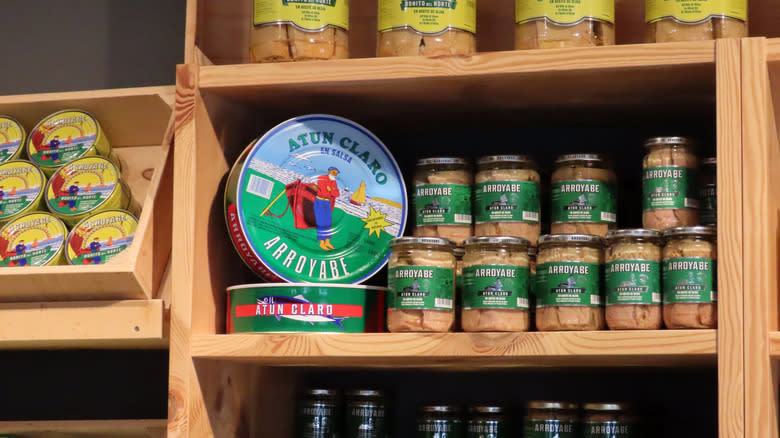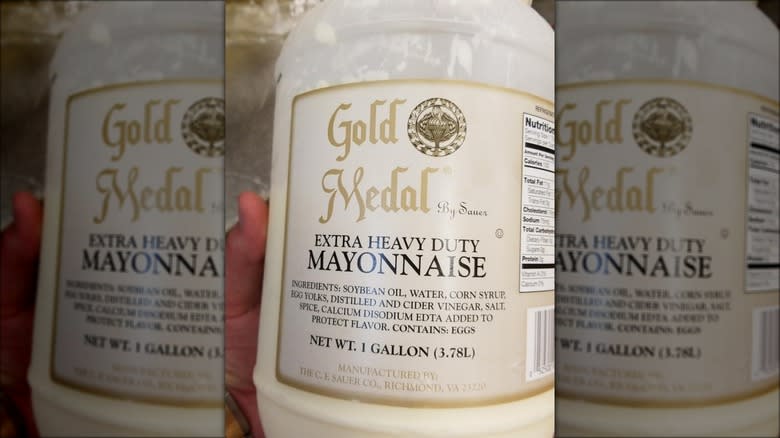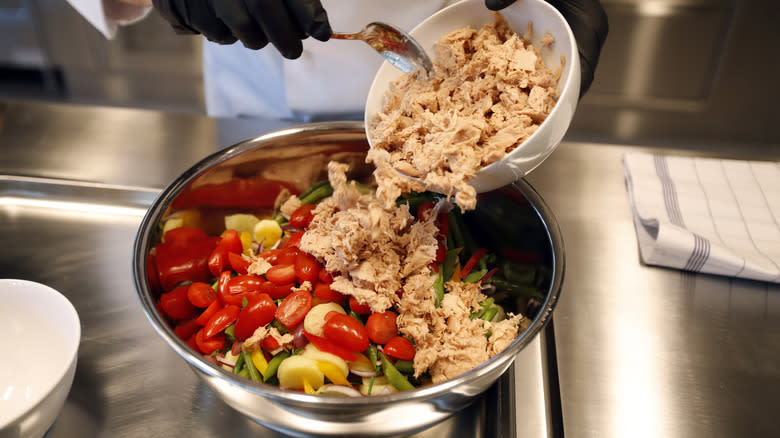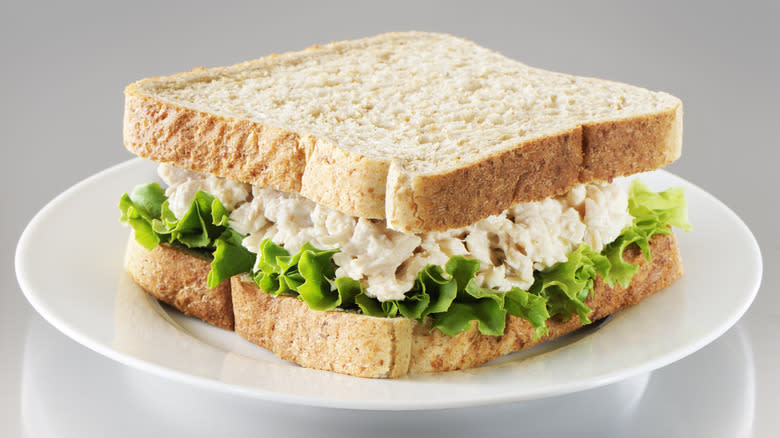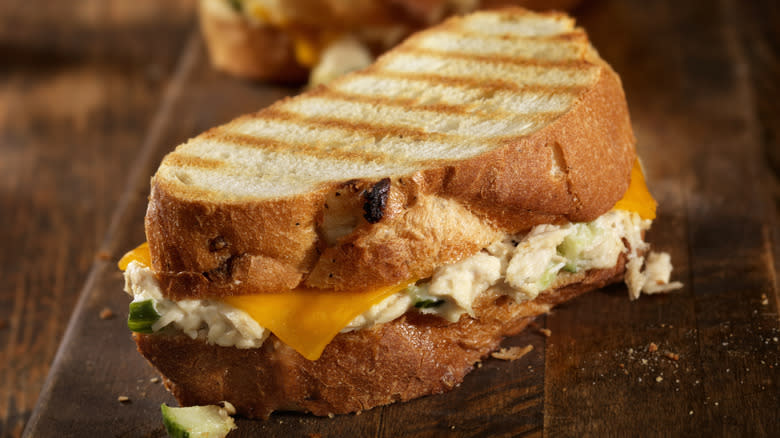According to research undertaken by the National Fisheries Institute (NFI), canned tuna is the third most consumed seafood in the United States. The popularity of tuna is nothing new; canned tuna first became widely consumed in the early 20th century, when it served as an alternative source of protein for American troops during World War I. The fish remains popular today due to its inoffensive flavor, which is minimized when packed in brine or neutral oils. It's not for nothing that tuna has become known as the chicken of the sea.
TheNFIalso reports that the majority of canned tuna is eaten in sandwiches. This is thanks to the popularity of tuna salad, a sandwich filling that was originally seen as a food for women. Today, however, tuna salad is enjoyed by all and is a regular feature on the menu of delicatessens and restaurants across the United States.
Those who eat tuna salad at these establishments are often surprised by how much better professionally made versions of the dish taste when compared to tuna salad made at home. Given thatmaking tuna salad requires little technique and next to no expertise, many people wonder howprofessional chefs make their tuna salad stand out. The answer, as is so often the case when it comes to cooking, is a multifaceted one.
Read more: 12 Underrated Types Of Fish You Should Try At Least Once
They Use High-Quality Tuna
As the star ingredient, there is no way of masking the taste of texture of subpar tuna, especially in a dish with so few components. This ensures that restaurants often use high-quality tuna. The highest-quality tuna is bought fresh from the market or fishmonger, so some restaurants process and cook fresh tuna before incorporating it into the tuna salad. Although time-consuming and expensive, many chefsprefer this approach.
Not all restaurants can afford to go this route, though. As a result, a lot of chefs instead rely on canned products to make their tuna salads. Using canned tuna does not mean that the focus on quality is eschewed. In fact, many restaurants use exceptional canned tuna, much of it imported.Generally, these chefs prefer to use solid, white albacore canned tunaas ithas a superior,meaty texture.
When it comes to using water versus oil-packed tuna, opinions differ. Water-packed tuna creates a lighter, brinier tuna salad, which some chefs prefer. On the other hand, oil-packed tuna will create a more indulgent tuna salad, as chef Charlotte Langley highlighted to Martha Stewart: "As a longtime seafood chef, I prefer my tuna packed in olive oil for richness, mouthfeel, and moisture. I prefer to use the whole contents of the can, oil included."
Everything Is Cut Uniformly
Although tuna salad requires little preparation to make, restaurants still pay a lot of attention to how it is constructed.This is most noticeable in how all the ingredients added to the tuna salad, including onion and celery, are cut. Aside from changing the look of the dish, varying the size of the cuts will influence its flavor. For the onion, smaller dices will give the tuna salad more punch. Charles Forney, a crop physiologist, explained to NPR,"If you cut an onion or garlic, you release an enzyme called alliinase that produces the typical pungency or onion or garlic aroma ... The enzymatic reaction forms the flavor — so the more finely it's cut, the more flavor that will be released." Alternatively, celery might be cut a little larger to ensure it doesn't lose its crisp texture. Generally speaking, a ¼ inch-sized diceis the perfect size, although each and every individual will have their own preference.
More important than the selected size of the cut is the uniformity of them. Eating a tuna salad full of various-sized chunks of onion is a jarring experience. Restaurants know this and take the time to produce a dice that's uniform in size. Ultimately, this translates into a tuna salad that is free of nasty surprises.
Health Concerns Take A Back Seat
It is a well-known fact that chefs don't often cook with health at the forefront of their mind. After all, their job is to make food taste good, not healthy. As a result, professional chefs often pack their dishes with salt and fat in order to maximize their flavor. Home cooks, on the other hand, tend to be a bit more cautious. The difference between professional and home cook's approaches was highlighted by chef Jacob Kennedy, who said to The Guardian: "Correct seasoning to a chef is as much salt as you can put in without it tasting too salty." On the other hand, home cooks rarely add more than a pinch.
The prolific use of salt is common in restaurants that make tuna salads. For example, Panera Bread's Tuna Salad Sandwich contains 1,670 milligrams of sodium, which is over half an adult's daily recommended allowance. And it's not just salt; restaurants also serve tuna salads that are packed with fat. This is due to the use of heavy-duty mayonnaise, which contains more egg yolks than regular mayonnaise. This thicker, fattier condiment gives restaurant tuna salad a richer flavor when compared to tuna salad made by home cooks using regular mayonnaise.
The Salad Sits For A Long Time
Most home cooks make tuna salad just before eating it. Restaurants, on the other hand, make tuna salad in bulk and ahead of time, as it would be too inefficient to make it fresh for every order. The upshot of this is that restaurant tuna salad often sits in storage for a long duration before it reaches the customer.While heat doesn't accept any changes in the tuna salad during this time, other processes do affect the food, including oxidation. Ultimately, this leads to the tuna salad tasting better for reasons explained to HuffPost by professor of sensory science Chris Simons: "As foods start to metabolize or change, different compounds are being generated and different types of reactions are taking place within that food matrix. That allows new flavors to either be created or be released or [it creates] textural changes."
In short, allowing the tuna salad to sit gives the flavors an opportunity to meld together, creating a more well-rounded dish. Thankfully, those cooking at home can easily factor this knowledge in as long as they have a little forethought. All home cooks have to do in order to reap the same benefits is make tuna salad 12 to 24 hoursbefore they need it. (Keep it in the fridge in the meantime, of course.)
They Use Interesting Ingredients
Tuna salad is usually a straightforward dish with few components. However, this doesn't mean that it cannot be upgraded through the inclusion of slightly unconventional ingredients. Many chefs do just that. For example, Valerie Bertinelli adds pickled jalapeñosto her tuna salad sandwich. Jalapeños provide the tuna salad with spice, adding an extra dimension to this dependable sandwich filling. Others, including ex-chef Daniel Gritzer, boost tuna salad's umami through the addition of fish sauceor even minced anchovy. Rick Gencarelli, owner of popular Portland-based sandwich shop Lardo, goes one step further, serving an Italian Tuna Meltthat's stuffed with provolone, olive tapenade, and fennel.
Of course, some chefs like Gordon Ramsay go further still by using luxury ingredients to boost their tuna salad. Ramsay uses quail eggs in his tuna salad for reasons he explained to Tasting Table: "First of all, they're a pain in the ass to peel. Anything that's difficult to get a hold of is worth enjoying and eating 10 times more [...] Providing that yolk is runny, aesthetically, it's good enough to sit on the front cover of a foodie magazine." Needless to say, such ingredients are rarely used by home cooks, meaning their tuna salads often pale in comparison.
Presentation Is Considered
How food is presented has a real impact on how we perceive taste. Various scientific studies, including one published in the journal Appetite(via ScienceDirect), revealed a positive correlation between attractive presentation and whether a food or meal was said to taste good. By taking into account the arrangement of food, as well as what tableware is used, restaurants improve our eating experience.
In terms of tuna salad, home cooks usually keep presentation simple, placing it inside some bread before cutting and eating. Some chefs, however, go far beyond this, serving tuna salad in unique and visually striking ways that ultimately improve the dish's perceived taste. One such chef is Carla Hall, who servestuna salad insidea halved iceberg lettuce.
Other chefs might not serve such an alternative take, but they all focus on presentation, taking into account key areas, which were highlighted by chef Jim Solomon to Lightspeed: "Food should have an element of height or visual texture, the balance of colour and thoughtful garnishes -- both carefully placed and intentional in flavour and texture." Restaurants often achieve this by simply serving a brightly colored salad alongside a tuna salad sandwich, or stacking the sandwich itself to give the dish some height.
Restaurants Consider Texture
Textural contrast is an essential part of good food; in a study published by the Journal of Texture Studies(via PubMed), participants mentioned textural contrast twice as much when describing food they liked. Those working at restaurants understand the important role texture plays in the enjoyment of food and build their dishes accordingly.
Mayonnaise-rich tuna salad has a very soft, moist texture. To provide textural contrast, many restaurants add crisp ingredients to the mixture, including diced celery and onions. If served in a sandwich, simply toasting bread or adding lettuce to the sandwich results in a gripping textural contrast.
Some chefs prefer to use even crisper ingredients. Martha Stewart is known to add finely diced appleas well as celery to her tuna salad, imbuing it with an even greater degree of crunch. Chef A.J. Walker opts to include several ingredients to ensure his tuna salad boasts enough contrast, as he highlighted to The Takeout: "I also like to add some crunchy stuff like raw celery, Chow Chow (it's essentially pickled corn, an ingredient we make at Anker, it also adds some nice acidity to the dish), and top it off with crushed up potato chips." Again, this is an approach home cooks can easily adopt to improve their own tuna salad.
Static Media owns and operates Daily Meal and Tasting Table.
Read the original article on Daily Meal.
